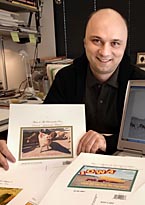Inside Iowa State
Inside ArchivesSubmit newsSend news for Inside to inside@iastate.edu, or call (515) 294-7065. See publication dates, deadlines. About InsideInside Iowa State, a newspaper for faculty and staff, is published by the Office of University Relations. |
April 1, 2005 Social awareness through postcardsby Teddi Barron In the new core program design studio he teaches, Igor Marjanovic gives first-year students a picture postcard of the Iowa countryside and a montage by John Heartfield, an artist and social critic from 1930s Germany. Marjanovic asks the students to combine the two and create a postcard of Iowa, looking beyond the stereotypical and uncovering the "silent arguments" of images not represented. One student's postcard shows an ear of corn grasped tightly in the raised fist of a disembodied arm made of dollar bills; another depicts Grant Wood's rolling hills obscured by a development sprouting rows of identical suburban houses. Many students communicate a common theme: destruction of the family farm. Marjanovic's "Postcard Project" uses postcard images and montage theories to help students develop a social awareness of the context of their design work. Montage uses a juxtaposition of images and text from existing photographs, magazines and newspapers to communicate a message. Generally, the messages criticize war, politics or social injustice. The "Postcard Project" also integrates the essential elements -- postcards, montage, social criticism and context -- that form Marjanovic's approach to his work, both as director of the College of Design's new curricular program for first-year students and as an architect and artist. "I'm interested in the context of design works -- in particular, how images, such as photographs and postcards, are used to create and popularize design works, like buildings, in different cultural contexts," said Marjanovic, an assistant professor of architecture and of art and design. He was hired in 2003 to lead the development and implementation of the core design program, a complete restructuring of the college's first-year curriculum. For the first time last fall, all 700 incoming design students began attending a common set of studio and lecture classes intended to prepare them for any of the college's professional degree programs. Globally educatedA native of Belgrade, Serbia, Marjanovic earned his bachelor of architecture degree from the University of Belgrade in 1998. He participated in study-abroad and internship programs in Brazil, Finland and Greece, and completed a one-year design thesis at the Moscow Architectural Institute. After practicing architecture in Belgrade for a several years, he went to the University of Illinois at Chicago (UIC), where he earned his master of architecture degree in 2000. Marjanovic worked at UIC as an adjunct assistant professor of architecture and interim director of undergraduate studies before joining Iowa State's faculty. He also worked for OWP/P Architects, one of the largest design firms in Chicago. Books and city exhibitionsWhile at UIC, Marjanovic began a collaboration with Katerina Ruedi Ray (now director of the School of Art at Bowling Green State University, Ohio) that has spawned a busy design practice, Ready Made Studio, and two books. Both books are practical guides for architecture students -- Practical Experience: An Architecture Student's Guide to Internship and the Year Out (2004) and The Portfolio: An Architecture Student's Handbook (2003). The two designers currently have an exhibition at the Art Institute of Chicago, "Chicago City of Arrivals," that looks at the history of immigration in Chicago and how the urban space is shaped and defined by the flow of immigrants in the city. The modernist BoyarskyMarjanovic is completing his doctoral dissertation at The Bartlett School of Architecture, University College London. His research is a study of the life and work of Alvin Boyarsky. One of the most influential architecture educators of the 20th century, Boyarsky also collected postcards, using them to tell the urban history of Chicago. Like Boyarsky, Marjanovic appropriates historical and contemporary images -- both artistic and popular -- to teach his students about the role of design in everyday life. Last year, Marjanovic was awarded a $5,000 research fellowship from Iowa State's Center for Excellence in the Arts and Humanities for a project on interdisciplinary design education and interactive visual media in the work of Alvin Boyarsky. Marjanovic researched the historical role of photographs in design studio education. He outlined a long tradition of European modernists, including Boyarsky, who were fascinated with American economy and imagery. "Postcards are much more complicated than they look. They are a popular culture interpretation of the built environment and reflect the local economy," he said. "But postcards are interesting not only in terms of what their images say, but also in what's missing. For example, the contemporary picture postcards of Iowa show beautified farm scenes in which livestock look almost like pets. You don't see animals being killed, which is part of farming, too. In the 'Postcard Project,' we want students to look with a critical eye beyond the stereotypical image," Marjanovic said. "Design work is not isolated. It always operates in a very specific context and is shaped by social and economic issues," he said. Art's function in societyMarjanovic grew up during a tumultuous time of ethnic conflict following the dissolution of Yugoslavia. He went to high school and college during years of war. "It was a difficult time, very stressful," he said. "But it also gives you a particular experience, a very different perspective on life. You're growing up faster because you're dealing with very existential issues, such as death and survival." Coming of age in "a country with a history of wars and political conflicts" prompted his longstanding interest in the art form of montage. "I was drawn to montage because this type of art plays a very important ethical function in society," he said. "I believe there's a social role for designers. It's not just about making pretty things," Marjanovic said. "It's about looking at the bigger picture and seeing how design workers and artists can make a difference in society." |

Igor Marjanovic with student designs in the "Postcard Project." Photo by Bob Elbert. |